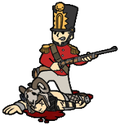|
mllaneza posted:The Glorious' third escort was the immortal Glowworm. Detached from the carrier she was intercepted by the Admiral Hipper. Caught in gun range by a heavier ship the captain, Commander Roope, did the only thing he could. He attacked with torpedoes and then rammed the cruiser. His Victoria Cross was awarded based on testimony from the captain of the Hipper, passed on through the Red Cross. Here's a copy of his award: Glowworm wasn't an escort for the Glorious. She was sunk two months earlier during the opening movements of the invasion of Norway after becoming detached from a British task force based around the battlecruiser Renown. She ran into the Hipper and a bunch of other German ships as a result of the bad weather. Also I'm quite shocked people are repeating the old and inaccurate canard that the battlecruiser's main weakness was inadequate armoring. The British ships at Jutland were lost through completely inadequate magazine safety arrangements which were completely separate issues to the thickness (or lack thereof) of the armor they carried. That's not to mention Beatty's absolutely atrocious handling of his squadrons during Jutland (although thankfully that was actually mentioned). Vincent Van Goatse fucked around with this message at 04:24 on Mar 28, 2014 |
|
|
|

|
| # ? May 16, 2024 15:17 |
|
Saint Celestine posted:Bitter shame she was scrapped. The grand old lady deserved better. The Enterprise is the one that always depressed me. One of the most greatest and most decorated ships in US Navy history, and they just sold her for scrap, even as various groups were trying to save her. A drat shame if there ever was one. At least the Saratoga got to go out with a bang. 
|
|
|
|
ALL-PRO SEXMAN posted:Also I'm quite shocked people are repeating the old and inaccurate canard that the battlecruiser's main weakness was inadequate armoring. The British ships at Jutland were lost through completely inadequate magazine safety arrangements which were completely separate issues to the thickness (or lack thereof) of the armor they carried. That's not to mention Beatty's absolutely atrocious handling of his squadrons during Jutland (although thankfully that was actually mentioned). Are you referring to my comment about British BC deck armor? I assure you that that has nothing whatever to do with (the charge ignitions at) Jutland, and simply reflect that such a level of horizontal protection is largely insufficient for the different threats in an environment featuring aircraft bombs and long range plunging fire. Specifically, a long-range duel with the 11"/52 SK C/28 poses a non-trivial threat. Arguably even after the 1930s adjustments to Refit and Repair's deck armor, obviously not a factor at the time the Panzerschiffe armament was selected.
|
|
|
|
The Merry Marauder posted:Are you referring to my comment about British BC deck armor? I assure you that that has nothing whatever to do with (the charge ignitions at) Jutland, and simply reflect that such a level of horizontal protection is largely insufficient for the different threats in an environment featuring aircraft bombs and long range plunging fire. Specifically, a long-range duel with the 11"/52 SK C/28 poses a non-trivial threat. Arguably even after the 1930s adjustments to Refit and Repair's deck armor, obviously not a factor at the time the Panzerschiffe armament was selected. No, I wasn't. But since you bring it up, the thinness of the deck armor was a design flaw but it was pretty common across the board and not specific to the battlecruisers. At least in the pre-WW1 days plunging fire wasn't treated with the respect it deserved, designwise. Vincent Van Goatse fucked around with this message at 05:38 on Mar 28, 2014 |
|
|
|
Oops. You're right, though - indeed, most early gun mounts couldn't elevate far enough to create much plunging fire, but I was commenting in the context of things that could overtake the Deutschlands.
|
|
|
|
ALL-PRO SEXMAN posted:Also I'm quite shocked people are repeating the old and inaccurate canard that the battlecruiser's main weakness was inadequate armoring. The British ships at Jutland were lost through completely inadequate magazine safety arrangements which were completely separate issues to the thickness (or lack thereof) of the armor they carried. That's not to mention Beatty's absolutely atrocious handling of his squadrons during Jutland (although thankfully that was actually mentioned). I'd be interested to see you expand on this. Shell handling practices and the nature of cordite suggests that a British ship was more at risk from a catastrophic explosion on a penetrating hit than a German one. More armor means a better chance of keeping the shells out. So I'd love to see an analysis or some sources.
|
|
|
|
The explosions that destroyed the British battlecruisers at Jutland all started after shells penetrated their turrets, which were the most heavily armored parts of the ships. The subsequent explosions of those shells sent flash down into the magazines, setting off the cordite stored within. There were doors between the magazines and the turrets themselves that were meant to be sealed between firing to prevent flash traveling down to the magazines, but these and other precautions weren't in use at Jutland because they slowed down the turrets' rate of fire too much. The fact that the parts of the battlecruisers with the heaviest armoring were where the fatal hits happened pretty much shows how the idea that weak armor was to blame for their loss isn't terribly convincing. More deck/belt armor wouldn't have saved any of them because that armor wasn't where the fatal hits happened. Sources are pretty much anything written about Jutland in the last few decades. I can dig up more specific ones later, though.
|
|
|
|
The German had an advantage on this because they almost lost the Seydlitz during the Battle of the Dogger Bank. As said, a hit in one of the aft turrets created a fire that flashed down to the magazine and almost destroyed the ship. After this, the germans installed the anti-flash doors in order to prevent this from happening again. The Lion also had a fire during this battle but it was contained, so the British never really learnt their lesson and didn't have the same precautions that the Germans had concerning preventing flash fires from taking out their ships, which is exactly what happened at the Battle of Jutland.
|
|
|
|
Acebuckeye13 posted:The Enterprise is the one that always depressed me. Fixed that.
|
|
|
|
Did the OKW have authority over the OKH in the Nazi command system? I mean, that would make sense wouldn't it but they had a huge rivalry right?
|
|
|
|
Shimrra Jamaane posted:Did the OKW have authority over the OKH in the Nazi command system? I mean, that would make sense wouldn't it but they had a huge rivalry right?
|
|
|
|
WEEDLORDBONERHEGEL posted:Yes, but before Hitler assumed supreme commend they needed his permission for any order. How does that even work, something like the Fall of France was a very fast moving affair, did they actually send every order to Hitler, or did Rommel and Guederian just say "gently caress everything, we're rolling" and didn't stop until they hit Paris? I've read that the reality was something closer to the latter, but the more I read about how Nazi Germany actually worked (or didn't, as the case may be) the more I feel that they really did stop everything and wait for Hitler to rubberstamp their orders. It makes about as much sense as some of the other weird poo poo they did, like the invasion of Crete.
|
|
|
|
Shimrra Jamaane posted:Did the OKW have authority over the OKH in the Nazi command system? I mean, that would make sense wouldn't it but they had a huge rivalry right? Nazi command system is the wrong word, or at least you'd fool yourself by thinking that the military and the party was the same complex. Putting "Weltanschauungsgeneräle" in place was a gradual process that runs hand in hand with military misfortune. Hitler would plant more and more of "his" Generals in the OKW and OKH as the war progressed. The leadership of 1940 was pretty much independently minded - the old elites, looking to opportunities to get rid of Hitler. With the initial success in France, that was impossible. The OKH had authority in the immediate area of the front, everything behind that was at the command of the OKW. Like in the Wikipedia articles stated, *formally* the OKH was subordinate to the OKW. Don Gato posted:I've read that the reality was something closer to the latter, but the more I read about how Nazi Germany actually worked (or didn't, as the case may be) the more I feel that they really did stop everything and wait for Hitler to rubberstamp their orders. It makes about as much sense as some of the other weird poo poo they did, like the invasion of Crete. Not really. The concept of "Rahmenbefehl" is what you are looking for. Hitler would issue a general goal, it was your job to think up a way to archieve it. When doing so, you have to keep in mind what Hitler wants. So you pick the most radical solutions. Those orders were often very blurry, that wasn't an accident. You'd often have to come back and ask Hitler for his opinion how things are to be done, but also because those orders were bound to make different departments of the establishment to get into conflict. There were no clear hierarchies among the greater blocks of power, headed each by one of Hitler's Paladins, so when they get on each other's turfs, they'd have to consult Hitler to rubberstamp *their* plans. Hitler intruding into every detail is a later development that occurs at strenght at around 1943 if my memory doesn't fail me. Power Khan fucked around with this message at 07:34 on Mar 29, 2014 |
|
|
|
ALL-PRO SEXMAN posted:The explosions that destroyed the British battlecruisers at Jutland all started after shells penetrated their turrets, which were the most heavily armored parts of the ships. The subsequent explosions of those shells sent flash down into the magazines, setting off the cordite stored within. There were doors between the magazines and the turrets themselves that were meant to be sealed between firing to prevent flash traveling down to the magazines, but these and other precautions weren't in use at Jutland because they slowed down the turrets' rate of fire too much. Good programme about Jutland, analysis and explanation of the cordite issue from the 36 minute mark. https://www.youtube.com/watch?v=uQCH-05Ijao&list=PLQWreeIIVSlVjaPyXoYUz7W4CmgtIbxJ1
|
|
|
|
Waroduce posted:Hey so im like on pge67 and i dunno if this post ever happened but bro you should totally make it happen Will do in a week when I'm back from vacation.
|
|
|
|
Hogge Wild posted:I think he's referring to the part where everyone fights at the frontlines, even the generals, and there are no designated personnel in the logistics. Still, it's not even the silliest part in that book. quote:In fact, if the next few decades are anything like the last, most military personnel will never see combat. A recent McKinsey study found that the "tooth to tail" ratio in the active duty U.S. military was roughly one to three in 2008: for every service member in a combat or combat-support position, there were more than three service members in non-combat-related positions. A 2010 Defense Business Board study found that 40 percent of active duty military personnel had never even been deployed -- and that's during a decade in which the United States was at war in both Iraq and Afghanistan.
|
|
|
|
Waroduce posted:2012 source though. I recall reading a passage in a Dick Couch book, perhaps the Finishing School, Downrange, or the Sheriff of Ramidi that for SEALs, tooth to tail, is something like 79 or 80 people for every single SEAL. Why's that so high? The various trainers required for all the stuff they gotta know?
|
|
|
|
Waroduce posted:2012 source though. I recall reading a passage in a Dick Couch book, perhaps the Finishing School, Downrange, or the Sheriff of Ramidi that for SEALs, tooth to tail, is something like 79 or 80 people for every single SEAL. Really interesting stuff.
|
|
|
|
Remember when people asked me about that book about military superstitions I have? My schedule has cleared out, so here's the first half of my report on it. Der Krieg in Aberglauben und Volksglauben: Kulturhistorische Beiträge by Dr. E.M.Kronfeld, Wien. Published 1915, dedicated to the author's brother, k.k. Oberartzt Dr. Robert Kronfeld. I hope he made it. Dr. Kronfeld seems to be an amateur antiquarian, because this book is kind of haphazardly organized. Discussions of the ancient Germanic attitude towards whatever he's talking about sit comfortably side-by-side with medieval or contemporary anecdotes he picked up from folklore studies, ethnography, literature, or his own experience. There's an entire chapter on astrology in Schiller's “Wallenstein” trilogy. He's probably also a medical doctor, like his brother: while he is more than willing to give most of his topics the benefit of the doubt (he knows that turquoise feels emotions and picks up on the emotions of its owner, for instance, because when he was a child he saw with his own eyes a piece of turquoise darken as the Franco-Prussian war was beginning), he draws the line at early modern medical practices. Charms and spells are a lovely link to our pagan Germanic heritage, but putting white lead or donkey poo poo on wounds—that's “nonsense.” The overall effect is that you're listening to your weird uncle talk about his interests, if your weird uncle is a Viennese folklorist in the nineteen-teens. You can smell the pipe smoke. It's rather pleasant. (I should probably mention that Dr. Kronfeld, despite his interest in the Germanic past, does not appear to be a racist. He quotes Old Testament examples as well as examples from African ethnography.) Some Things He's Heard About
How To Make Yourself Bulletproof Inspector Bloor already mentioned people called “Gefrorener” (frozen people) or the so-called “Passauer Kunst” in this thread before. “Passauer Kunst,” named for the “Executioner from Passau” Neidhart Kaspar who supposedly wrote a book about it (executioners had magic powers), is the secret art of making yourself unwoundable through magic. Some spells say they will make you bulletproof, some cover all weapons. But there's a sense of a hidden catch in a number of stories—like Wallenstein's comrade Adam Trczka, who had made himself bulletproof and managed to briefly withstand the attackers who had come to kill him; the bullets bounced off, but he was clubbed to death. It's as though the protected person must pay some dark balance for what they did. The part where Trczka wore an elkskin collar is ignored. Some commentators don't like this because it might be dealing with the devil, but stories where this sort of thing is deeply negative or blasphemous are Romantic, meant to evoke a frightening image of the barbarous Early Modern. In fact, what magic is was hotly debated at the time—a lot of people think it's another branch of science, another way to tap into the hidden correspondences that govern a universe of patterns and connections. Some people hate it because it's superstitious, by which most of them mean “looks kind of Catholic.” And a bunch of the rituals do make use of the Catholic Host, or require sneaking into a Catholic church and hiding the talisman-in-progress in the altar. Do you have to sneak around? It's possible that some of the priests at the time might have let you use their altars quite openly. (Not Luther, though. He said trying to protect yourself through magic meant a lack of concern for obeying the will of God alone.)
How to Shoot Better and Healing tomorrow. HEY GUNS fucked around with this message at 13:15 on Mar 31, 2014 |
|
|
|
WEEDLORDBONERHEGEL posted:“A soldier of the Thirty Years' War allowed himself the amusement, when asked by a cowardly comrade who wanted the means of making himself bulletproof, of writing “Protect yourself, rear end in a top hat!” [“Wehr' dich, Hundsfott!”] three times on a slip of paper. It worked: the man thought he was invulnerable and shot himself.” Oh, the rich lulz that were had that day! Ahahaha!
|
|
|
|
Waroduce posted:2012 source though. I recall reading a passage in a Dick Couch book, perhaps the Finishing School, Downrange, or the Sheriff of Ramidi that for SEALs, tooth to tail, is something like 79 or 80 people for every single SEAL. I couldn't find the origin of that tooth-to-tail ratio in the sources through the link in that article, but I'm guessing that they're just defining combat positions through MOS or combat pay, so it's likely that would include a lot of people who were probably by and large away from immediate danger (by which I don't mean to denigrate their service, of course), and in reality the number of those bearing the brunt of the combat and casualties would be much smaller than 1 in 3. I wonder if there are numbers anywhere for what percent of US forces earned CIBs or what-have-you. Edit: Ah, wikipedia has a number for Iraq: 42,269, which considering the number of people who cycled through there is pretty drat small I'd think. Does anyone know if CIBs are actually consistently awarded properly, or are there a lot of cases of people being in combat and their officers just not going through the paperwork to get them CIBs? LimburgLimbo fucked around with this message at 11:18 on Mar 31, 2014 |
|
|
|
LimburgLimbo posted:Edit: Ah, wikipedia has a number for Iraq: 42,269, which considering the number of people who cycled through there is pretty drat small I'd think. Does anyone know if CIBs are actually consistently awarded properly, or are there a lot of cases of people being in combat and their officers just not going through the paperwork to get them CIBs? CIBs are pretty common, and are generally handed out pretty promptly. The requirements are pretty simple, but it should be noted that it is limited to US Army infantry or special forces MOS. So you can't get it if you're a medic in the field or an MP on patrol, nor if you're a Marine or sailor. A "tooth to tail" of 80 to 1 seems absurd to me, and I'd expect that it takes some real number bending to come up with it. For example, my friend was an Intel officer in Iraq and would surely be considered part of the "tail" if anyone was, but he still went on vehicle patrols and got into combat. Kaal fucked around with this message at 15:48 on Mar 31, 2014 |
|
|
|
LimburgLimbo posted:I couldn't find the origin of that tooth-to-tail ratio in the sources through the link in that article, but I'm guessing that they're just defining combat positions through MOS or combat pay, so it's likely that would include a lot of people who were probably by and large away from immediate danger (by which I don't mean to denigrate their service, of course), and in reality the number of those bearing the brunt of the combat and casualties would be much smaller than 1 in 3. I wonder if there are numbers anywhere for what percent of US forces earned CIBs or what-have-you. They'r awarded very meticulously. That being said, the Army realized it is kind of stupid to single out infantrymen in a military where everyone gets shot at regardless of your MOS so they came up with the Combat Action Badge of which they've awarded over 100k. There is also a special badge for medics (CMB). Really, "tooth to tail" ratios are completely useless metrics in my opinion. There are far too many variables (ie, what is "tooth" and "tail" exactly"), nor is having a high or low ratio inherently bad or good.
|
|
|
|
What are some examples of new strategies or tactics used to overcome significant problems in the history of war? Specifically, ones that can be considered analogous to a breakthrough or discovery? I'm most interested in reading about more modern (i.e. past few centuries) examples. I imagine that such things are of interest to students of war, such as officer cadets or those in war colleges for learning how to plan an attack or defense.
|
|
|
|
Reminds me of Japan. In addition to the sorts of amulets that you can still find in every Buddhist or Shinto shrine, (for about $1-10) many soldiers would line their helmets and armor with 'pictures of the floating world.' Presumably (since this is Edo period Japan and soldiers needing to worry about actual warfare was a pretty academic concern) this was more an excuse to carry around shunga. Merchants also like to claim that it protected their goods from fire.
|
|
|
|
Love Stole the Day posted:What are some examples of new strategies or tactics used to overcome significant problems in the history of war? Specifically, ones that can be considered analogous to a breakthrough or discovery? Just tactically, I'd guess the modern fire and maneuver is a pretty big deal. It's a response to technology (increasingly accurate and rapid fire infantry weapons) that sorta came out during but really after WWI. Other people in the tread know more than me. Going back a bit further, the levee en masse is considered a big deal.
|
|
|
|
the JJ posted:Just tactically, I'd guess the modern fire and maneuver is a pretty big deal. It's a response to technology (increasingly accurate and rapid fire infantry weapons) that sorta came out during but really after WWI. Other people in the tread know more than me. Trench warfare was also one of the big responses to both accurate weapons and the levee en masse. The devastating battles of the American Civil War (and later WWI when Europe caught on) were causing such massive casualties that commanders were eventually forced into adopting more defensive stances. While our vision of the Civil War is often of the big Napoleonic ranks firing at each other, the harsh reality of those bloodbaths meant that the war also saw the invention of trench fighting - which in turn led to the adoption of heavy artillery tactics, chemical warfare, armored vehicles, and eventually mechanized infantry. Each was a response to the new realities introduced by its predecessor.
|
|
|
|
Love Stole the Day posted:What are some examples of new strategies or tactics used to overcome significant problems in the history of war? Specifically, ones that can be considered analogous to a breakthrough or discovery? Aircraft. Fixed wing, lighter than air, tethered balloons, whatever. The ability to get up above the battlefield and see past the next hill was an enormous change in warfare.
|
|
|
|
MrYenko posted:Aircraft. Fixed wing, lighter than air, tethered balloons, whatever. The ability to get up above the battlefield and see past the next hill was an enormous change in warfare. In addition to just being able to see over the next hill, you have concepts like Douhet's idea of using aircraft (specifically bombers) to bypass a nation's fielded military forces to strike directly at a nation's populace without having to fight through their entire military first. Of course that gets into the whole
|
|
|
|
Thanks for the I'm very interested in similar things to these Warden's Five Rings. Especially more practical ideas and problem solving techniques that you guys were telling me about. As a specific example, in Band of Brothers when the main characters attacked a fixed position (2nd chapter?), there was a caption later saying that their idea for that became a new standard. Does anyone know where I can read more about that and things like it?
|
|
|
|
Love Stole the Day posted:As a specific example, in Band of Brothers when the main characters attacked a fixed position (2nd chapter?), there was a caption later saying that their idea for that became a new standard. Does anyone know where I can read more about that and things like it? What you're referring to is the Brecourt Manor Assault. It's considered a classic example of American small unit tactics and leadership. Despite minimal field intelligence, and shortly after assuming command of Easy Company after the entire HQ unit was killed, 1LT Winters led one of his platoons on an attack of an entrenched artillery position. Recognizing that the trenches were simultaneously a strength and a weakness, his unit attacked through the trenches using them as cover from the surrounding positions. Here's a clip of it from the TV adaptation and the wiki on it: http://en.wikipedia.org/wiki/Br%C3%A9court_Manor_Assault https://www.youtube.com/watch?v=wB6QQ1rK94I Now you may notice that while this event is notable for how the unit adapted to the situation and turned a very difficult fight (23 light paratroopers versus a heavily entrenched complex with 60 soldiers) into a win, it also is relatively short on specific tactical advice. For that kind of thing, I would recommend checking out the US military battle drills. BD1 "Platoon Attack" and BD2 "React to Contact" are the big ones that form the basis for modern small unit tactics. BD7 "Enter/Clear a Trench" would be the one applicable to the Brecourt Assault. They come in regularly updated field manuals that you can pick up at any surplus store, but you can also find them online. Specifically this one comes from one of the recent versions of ARTEP FM7-8 - you can tell since they're using laser pointers and infrared beacons whereas the older versions used whistles and marking sticks: http://www.armystudyguide.com/content/EIB/EIB_Related_Battle_Drills/index.shtml Kaal fucked around with this message at 21:21 on Mar 31, 2014 |
|
|
|
Love Stole the Day posted:What are some examples of new strategies or tactics used to overcome significant problems in the history of war? Specifically, ones that can be considered analogous to a breakthrough or discovery? I always like the story of the Thach Weave: http://en.wikipedia.org/wiki/Thach_Weave
|
|
|
|
the JJ posted:Reminds me of Japan. In addition to the sorts of amulets that you can still find in every Buddhist or Shinto shrine, (for about $1-10) many soldiers would line their helmets and armor with 'pictures of the floating world.' Presumably (since this is Edo period Japan and soldiers needing to worry about actual warfare was a pretty academic concern) this was more an excuse to carry around shunga. Merchants also like to claim that it protected their goods from fire. $1-$10, huh? Good deal.
|
|
|
|
Love Stole the Day posted:Thanks for the From an aviation perspective, the first thing that comes to mind is the Thatch Weave that was already mentioned. Robin Olds's Operation Bolo is a pretty interesting operation. The basic concept was nothing new (fighter sweeps had been around for decades) but how it was executed involving some pretty innovative thinking to get around political Rules of Engagement limitations as well as ensuring an engagement that played to the Phantom's strengths and the MiG's weaknesses. Another example from Vietnam is the idea of Wild Weasels...suffering too many losses from enemy SAMs? Come up with a plan to destroy the SAM sites that involves hanging yourself out there as a decoy to get the enemy to turn on his radar and then hope you can engage him before he engages you. It ties in somewhat with Warden's Five rings and I'm not sure if it's what you're looking for since it's more technological than anything else, but it's hard to overstate just how much of an impact the rise of Precision Guided Munitions have had on the conduct of an air campaign (particularly "fire and forget" GPS guided munitions, as opposed to LGBs that require constant illumination). It used to be in the not too distant past (Desert Storm, even the Balkans campaigns in the '90s to some degree) that you had to calculate how many bombers per target, now you calculate how many targets per bomber. Here's a great example of what I'm talking about : https://www.youtube.com/watch?v=bjoMQRUWEe8 One bomber, 80 bombs, one pass, successful engagement of 11 different targets (more if you count each individual vehicle).
|
|
|
|
WEEDLORDBONERHEGEL posted:The early 20th century, definitely, but this Passauer Kunst thing was full of do-it-yourselfers. I don't think anyone sold those little talismans, or Emergency Shirts, in an organized way. The high school history books always made a big deal of the ghost shirts of the native Americans and the magic headbands of the Boxer rebellion. Is good to know that superstition in the face of anonymous industrial warfare was so widespread.
|
|
|
|
Kaal posted:Trench warfare was also one of the big responses to both accurate weapons and the levee en masse. The devastating battles of the American Civil War (and later WWI when Europe caught on) were causing such massive casualties that commanders were eventually forced into adopting more defensive stances. While our vision of the Civil War is often of the big Napoleonic ranks firing at each other, the harsh reality of those bloodbaths meant that the war also saw the invention of trench fighting - which in turn led to the adoption of heavy artillery tactics, chemical warfare, armored vehicles, and eventually mechanized infantry. Each was a response to the new realities introduced by its predecessor. How close to WWI-style trench warfare did the ACW come to? I always hear about how Cold Harbor was a precursor, but I don't really know any details. The most I'm familiar with is Pickett's Charge and how the artillery barrage wasn't all that effective at suppressing the Union defenders (although there were other factors as well such as coordination and ammo supply)
|
|
|
|
sullat posted:The high school history books always made a big deal of the ghost shirts of the native Americans and the magic headbands of the Boxer rebellion. Is good to know that superstition in the face of anonymous industrial warfare was so widespread.
|
|
|
|
WEEDLORDBONERHEGEL posted:Remember when people asked me about that book about military superstitions I have? My schedule has cleared out, so here's the first half of my report on it. National Geographic mag had an article on Malacca strait pirates some years ago and it had this weird melting pot vibe of superstitions of people who at once were engaged both in violent crime (piracy) and in environmentally hazardous work (seamanship). Sailors are a notoriously superstitious bunch anyway but it was cool seeing that overlap from belief in superstition to belief in real and actual magic. Although I guess they're not really that far removed?
|
|
|
|
gradenko_2000 posted:How close to WWI-style trench warfare did the ACW come to? I always hear about how Cold Harbor was a precursor, but I don't really know any details. The most I'm familiar with is Pickett's Charge and how the artillery barrage wasn't all that effective at suppressing the Union defenders (although there were other factors as well such as coordination and ammo supply)
|
|
|
|

|
| # ? May 16, 2024 15:17 |
|
Frostwerks posted:National Geographic mag had an article on Malacca strait pirates some years ago and it had this weird melting pot vibe of superstitions of people who at once were engaged both in violent crime (piracy) and in environmentally hazardous work (seamanship). Sailors are a notoriously superstitious bunch anyway but it was cool seeing that overlap from belief in superstition to belief in real and actual magic. Although I guess they're not really that far removed? For instance, when Protestant observers denounce the Passauer Art as "superstition," what they mean isn't that it doesn't work, they mean either that it is superficially similar to Catholicism or that it involves doing something other than trusting in God. Meanwhile, everyone's medical practices, no matter your religious opinion or social background, is more or less magic. As we will see. HEY GUNS fucked around with this message at 04:02 on Apr 1, 2014 |
|
|






























